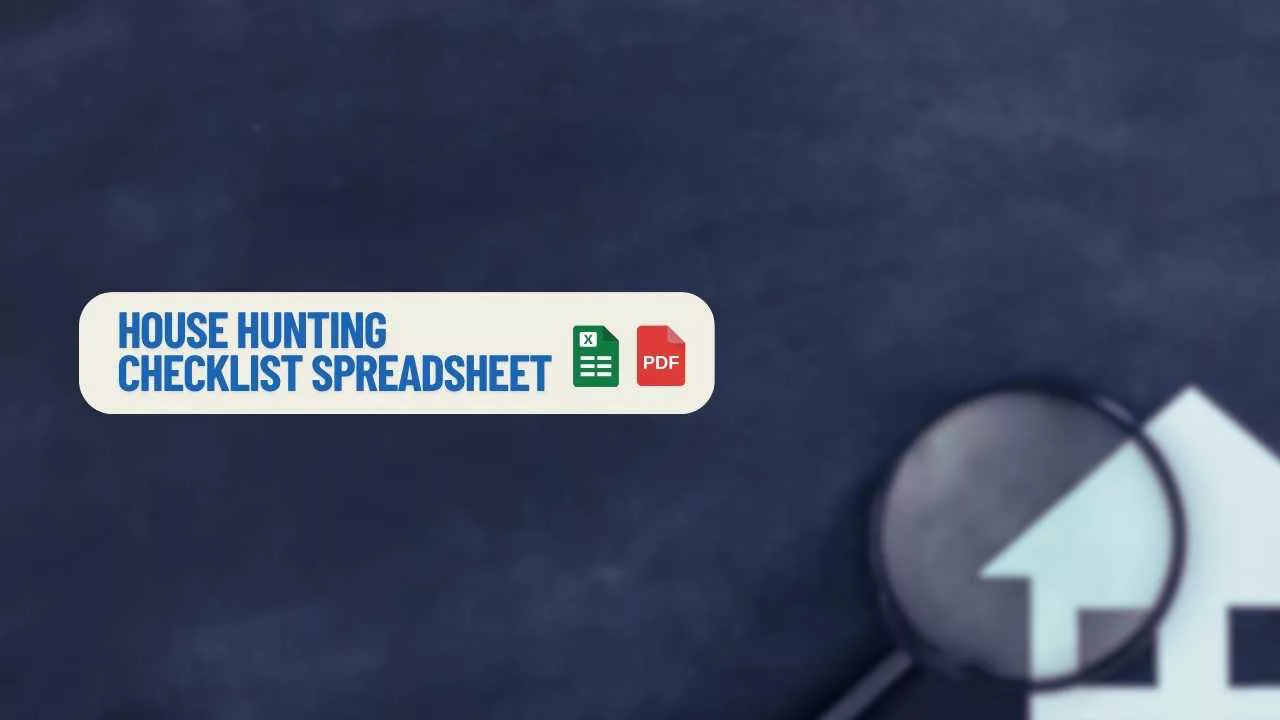House hunting is an exciting and overwhelming process. Keeping track of your budget, must-have features, and remembering which house caught your eye can be tough. That’s why my free house hunting spreadsheet, available in both Excel and PDF formats, can really help with your search. This tool is designed to keep your home buying process checklist organized and stress-free, streamlining everything into one easy-to-use system.
Download this Free House Hunting Schedule Template
Why You Need a House Hunting Spreadsheet
Ever finish touring a stunning home only to forget the must-know details by the end of the day? This complete house hunting checklist helps you organize key information like pricing, terms, and must-have features. With the right system, you can easily compare homes, track applications, and stay on top of deadlines. Create clarity and efficiency with a spreadsheet designed to save time and effort. My pro tip: use this handy home buyer tips tool to streamline your search like a pro.

Features of the Free House Hunting Spreadsheet
What sets this spreadsheet apart? It’s thoughtfully crafted to cover every element of your house-hunting process. Here’s what you’ll get in this bonus house hunting checklist buying guide:
- Property Comparison Tool: Compare multiple properties side by side, including details like purchase price, location, and square footage.
- Budget Tracking: Manage your expenses, including down payments, mortgage estimates, and closing costs. For more detail, you can use our property tax calculator.
- Features Checklist: Record must-have features and rank properties based on how well they meet your needs, ensuring a home checks all the boxes.
- Visit Tracker: Jot down important details and your impressions after property showings so you don’t forget what made a home stand out. A home inspection checklist can be a great companion here.

Location is absolutely key when looking to buy the best home and best investment for your family. What street is it on? Are your neighbors messy? My recommendation is that you get a home that’s in the middle—not the lowest and not the highest priced home on that street.
0:00 Are you buying a home and wondering what to look for in a home? 0:03 Today we’re going to talk about what to look for in a home. So stay tuned. 0:11 Hi this is Melody Wilson with the reLife team at RE/MAX Elite and today I’m talking to you about 0:15 what to look for in a home when you are buying the home and if you’re selling a home and you’re 0:20 watching this video take note of what buyers are looking for in a home. So some of the things I 0:26 strongly suggest that you look at and you can’t see this on pictures on mls necessarily 0:31 is the street that the home is located on. So location is absolutely key when looking to buy 0:37 the best home and best investment for your family, is what street is it on? Are your neighbors messy? 0:44 Is it a big mess? Is the yard a mess? Is there toys all over the place? Is there a main street nearby? 0:50 What’s going on in your neighborhood? What’s going on on that street? So take a look also not just at 0:56 those items but take a look also at the types of homes. So the home that you’re looking at is it 1:01 the smallest on the street? Is it the largest home on the street? Is it maybe just the same as every 1:06 other house? My recommendation is that you get a home that’s in the middle not the lowest and not 1:11 the highest price home on that street so if you are looking at a home that’s 1500 square feet 1:17 and that’s on the larger side and most of them are a thousand to 1200 square feet you just need to 1:22 be careful in terms of what your market value is going to be or maybe we should look at a different 1:27 location that that 1500 square foot bungalow is more common than not common. So another thing you Grading 1:34 should look for when you’re buying a home is the grading. So if you’re looking in a new neighborhood 1:39 a lot of times when you’re buying new the grading is not even done so you’re going to have to do 1:43 that item however if you’re buying in an older neighborhood depending on how old the neighborhood 1:49 is you may be looking at fixing grading issues. So any home in the 50s 60s 70s likely the grading has 1:57 sunk a little bit even the 90s and the early 2000s the grading has sunk. We live in Alberta things 2:04 shift and move all the time if you notice that on concrete there’s mud jacking that kind of are 2:12 different than the rest of the driveway means that the concrete is jacked but that it is no longer 2:18 pushed right down and not even with the garage itself that means the the ground has sunk and 2:24 that’s quite normal but if you need to be fixing that that’s a cost that you need to consider 2:29 when buying in those older neighborhoods, the cost of mud jacking the cost of fixing grading, 2:34 if there’s concrete on the side of the home then you’ll have to mud jack it up if the concrete’s 2:39 not broken, if it’s broken then it’s a bigger job in terms of getting the concrete removed 2:44 and putting in new grading. Now grating can also be just be done with dirt and that needs to be 2:49 done properly as well you don’t just dump a whole bunch of dirt and hope the grading is finished 2:53 and what’s the purpose of the grading? The grading is intended to keep water away from your house 2:59 so if the grading is going towards your house water is going to drain in towards your house 3:04 and pushing water into the basement into the foundation is not a good thing over time because 3:08 then you’re going to end up having water in the basement and that that is something we don’t 3:12 want to happen. Another thing to look for when you’re buying a home is the trees on the street if Trees 3:18 you’re in an older neighborhood there’s probably going to be some tree roots happening down below 3:23 where you cannot see and that’s why we recommend getting a sewer scope when you are buying an 3:27 older home just to make sure that the sewer lines are actually not disturbed by those tree roots and 3:32 then you’ll be able to see if anything needs to be addressed at that home inspection stage. 3:37 Okay so I’ve been talking about the outside of the home now one more thing before we go inside into 3:42 the home is take a look at the shingles if you can tell from coming into the home the shingles are 3:46 just in disrepair and they’re just curled up – time to get new shingles and it’s something that you’re 3:51 going to need to consider for cost. Okay so now we’re inside the house what are we going to look 3:56 for? What do I point out when we show houses to you? We are going to point out the conditions of the 4:00 homes the general condition of the home including the types of “upgrades” because sometimes they’re 4:07 diy hack jobs and they’re not really the greatest upgrades they’ve actually taken away value from 4:11 the home and that’s things such as baseboards that are all cut up and not properly done, 4:17 maybe there’s some really bad patching jobs, maybe the kitchen isn’t completely done properly, venting 4:24 is not done, like those are types of hack jobs and I say hacks because it was not done professionally 4:29 or to the proper standards of building and just cosmetic look so in general also what are we going Smells 4:35 to look at in a home it’s not with our eyes it’s with our nose. Are there smells? What kind of smells? 4:40 Are there smells of moisture? Are there smells of smoke? Is there smells of cannabis? All the smells 4:46 do impact the value of the home so we have to figure out what smells they are if they’re issues 4:52 that we can fix if they’re not issues we can fix and what it means to you as a buyer. Now ideally we 4:57 don’t have any smells in the home so we don’t even want to smell scents like air fresheners because 5:02 that’s always making me wonder what is the seller hiding. Now other things that you want to look for 5:08 in the home that we point out is the age of the windows and if the windows show a crack 5:13 if they’re broken but also the seals are gone on them, if the seals are gone on them then that’s when 5:18 moisture is going to be coming in and drafts are coming into the house. You don’t necessarily need 5:23 to have brand new windows in a older home but you do need to have windows that are making sure that 5:28 air stays outside and the cold air is not coming inside. Another thing I’m going to point out are Floors 5:34 the floors. Now what kind of condition are the floor is in? In the older homes you’ve got the original 5:39 hardwood sometimes hiding underneath the carpet or sometimes they’ve just already been redone. In a 5:44 new home of course the flooring is going to all be new so what kind of flooring is it? Is it the 5:48 luxury vinyl planking that’s very popular right now? Is it lino? Is it tile? Is it carpet? What kind 5:54 of floor is there and what kind of carpet do you want, what kind of underlay do you want, we’ll talk 6:00 all about that in terms of finishings. Now other things to look at in the home whether it’s new 6:05 or old is always look up – look at the ceiling and make sure that we see no signs of moisture and 6:12 how can you tell there’s signs of moisture? Well there’ll be yellowing on the ceiling and cracks on 6:18 the ceiling would also be a very bad thing. The only discrepancy there is if it is a drywall seam 6:24 then that’s okay with time but however yellowing you never want to see because that’s showing 6:29 us that there’s water damage, now when you do an inspection the inspector is going to be able to 6:33 pinpoint if there is active moisture or an active leak and we can kind of dig in further at that 6:39 stage. So also what we’re going to point out when we look at home is what does the floor plan look Floor Plan 6:45 like? What is the layout like? Is it something that works for your family? Is it something that maybe 6:51 needs to be changed and can it get changed? We’ll point out the ideas that we might have on how to 6:56 make this home a better flow for your family once you’ve told us what you’re looking for we can kind 7:01 of figure that out from the photos but we can also tell you in person in terms of what can be done 7:07 what we’ve seen it done in terms of renovations and upgrades. Now if you’re looking for a space 7:13 for a homeschool space or a work from home office or a bonus room space or bigger bedrooms 7:20 we kind of have to take a look at the flow of the house and see if it’s possible to do what 7:24 you’re wanting to do if it’s not already currently done and we also want to look at if it’s a income 7:30 property potential, some people are looking to put suites in the basement, so does the basement have 7:34 the plumbing in place, is it easily accessible, can we put laundry upstairs, can we put it downstairs, 7:39 so looking at the floor plan is going to be really important that’s something that we can potentially 7:45 change but there can be a big price tag depending on what other things that we’re doing in the house. Utility Room 7:50 So another thing we’re going to look at when you’re looking at the home is the age of the 7:54 furnace, hot water tank, electrical panel, that utility room is going to be a tell-all of extra 8:00 money that you may or may not need to spend and you also want to see the condition of that area. 8:05 That is the heart not necessarily like the kitchen, the kitchen is like the heart I guess, utility room is 8:11 like the brain of the house and if the brain is not functional that’s not a good thing so you 8:16 want to make sure that it’s clean in there, there’s no signs of water anywhere, you can see if the 8:22 homeowners have been taking good care and there’s been no neglect in that area. If there’s a ton of 8:27 storage crowded likely people aren’t accessing that regularly to keep it well maintained and 8:33 watch to see if there’s any issues so you want to take a look on that kind of thing we can see 8:38 typically those old furnaces you can tell because of just the color of the furnace, but there’s 8:44 also the stickers that you can look at as well. The other thing you can check on is the furnace ducts 8:49 if you see little black little rubber dots that are in the ducting it indicates that the furnace 8:55 at one point has been cleaned now how recent it depends on if there was a sticker placed on there 9:00 but just has been cleaned at one point. So when you’re looking at the home itself you just want 9:06 to make sure it has good bones now outside good bones you want to know if it’s needing any work 9:11 so cosmetic things is the next thing in terms of if you’re just move in ready, ready to go and if the 9:16 renovations were done nicely and the flow is great then that’s all the things of course that we look 9:21 for with our buyers who just want move in ready home. Now now we were outside talking about grading 9:27 but let’s not forget the backyard is the backyard the size that you want? Is it too large? Is it too 9:32 small? Is there access to the back alley? Do you want to have access to the back alley? 9:37 Also with the garage do you want it attached to the house? and sometimes when the garage is attached to 9:42 the home even though it looks like it’s attached it still doesn’t necessarily mean it’s attached 9:46 to the inside of the house so the older homes have the garage physically attached with the 9:50 door it’s actually from the back and you have to access it from outside to go back into the home. 9:56 So those are just some of the things that you should be looking for when you’re buying a home 10:00 it’s important to look at all these items and of course we guide you along so you don’t have 10:04 to remember this entire list but I wanted to go through roughly what we kind of go 10:08 through and point out to our buyers to let them know what’s a good home and what makes 10:13 a home to walk away from or what’s a home that’s worth buying and and possibly what the homes worth 10:18 going into multiple offers for because that’s become very common right now and you want to 10:23 make sure you have all your ducks in a row so that you know if you want to buy this house 10:27 that this home is good now we can still do a home inspection that’s so important to do when you’re 10:31 buying a home, so the inspectors can look at the home with their eyes and not just our eyes they’re 10:36 going to look beyond the surface of what we can not see and have not had the time to look through 10:41 things. Hopefully that helped if you’re looking to buy home this year and wondering how to navigate 10:45 today’s market make sure to send me a message or contact me and I’d be happy to talk to you. 10:51
How to Use the Spreadsheet
Using the house hunting spreadsheet is simple. Here’s a step-by-step guide to get started and figure out how much house you can afford.
- Download the Spreadsheet: Access the free spreadsheet by clicking one of the download links.
- Customize to Your Needs: Add or remove columns to make it your own.
- Input Property Details: Fill in the information for each home you tour, including its properties purchase history if available.
- Track Visits and Impressions: After an open house, use the notes field to record your thoughts. An open house checklist can be very helpful here.
- Compare and Rank Properties: Use the comparison tool to identify which properties best meet your needs in the local market.
Additional Resources to Aid Your Search
Combine this spreadsheet with other resources to fully equip yourself for the house-hunting experience. Agents can also download our real estate agent checklist for buyers to keep client tours efficient. For a broader tool that helps you track every step of the purchase process, check out our home buying spreadsheet. Explore even more real estate templates and spreadsheets to stay organized.
About the Author

Joseph E. Stephenson, REALTOR®
License #00054082 | Kansas & Missouri
Affiliated with Welch & Company (License #CO00000477)
Joseph E. Stephenson is a licensed real estate professional in Kansas and Missouri with a career built on dedication to integrity and client-focused service. To learn more about how Joseph can assist you in your real estate endeavors, visit his REALTOR® profile at realtor.com.
Verify Joe’s Real Estate License Credentials
Real Estate Agent License VerificationVerify Joe’s Business Credentials
Joseph E. Stephenson also operates a business named Stephenson Residential, LLC. You can verify the business at the Kansas Secretary of State’s website.
Verify Business Credentials



